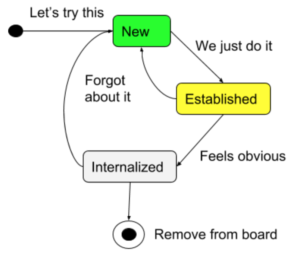I suspect that running a session with a team to help them bootstrap a Working Agreement, is the single most common workshop I’ve been facilitating the last couple of years. And I’ve learned a lot of what works for me (and what doesn’t work). In my experience, this approach works equally well for the agile team, the department management group and the steering board team. This blog is me documenting how I ended up facilitating these sessions.

For me, a Working Agreement captures the expectations we have on each other within the team when we collaborate and communicate. I’ve seen teams call it “Code of Conduct” or “Ways of Working”. I call it Working Agreement. You call it whatever makes sense for you.
Running a Working Agreement workshop as early as possible is crucial for setting the team up for success. Preferably it’s done during the team’s two-day kick-off offsite, or at least within the first few weeks as a planned structured workshop.


